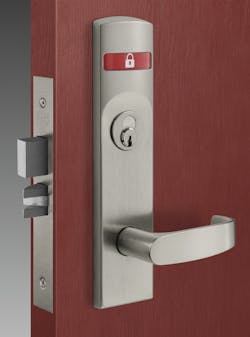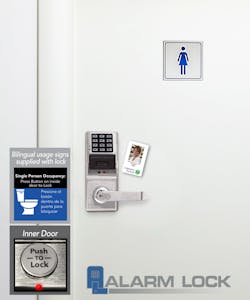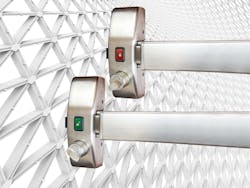Security, safety and privacy are issues that everyone has to understand. We put security controls in place to limit who can access locations and the information and contents inside.
Privacy is harder to define, but the concepts of security and privacy are related. It’s possible to have security without privacy but impossible to have privacy without security.
People are sensitive to the necessity for complete privacy when they use a restroom, during medical procedures and when they use a dressing room at a store or gym. The door hardware industry responded to privacy concerns associated with restrooms long ago through the introduction of a variety of privacy function locks. (See “Tech Tips: Lock Functions” in the April 2022 issue.)
Lock status indicators long have been used for locking devices, electronic access control (EAC) and door controls, but now there’s heightened interest in devices that provide an indication of the status of a lock and the area it controls. Status indicators for classrooms and restrooms are in particular demand these days. Some products and applications where status indicators or signs are used include:
- Request-to-exit switches
- Delayed egress
- Handicapped actuators
- Maglocks
- Classroom entry locks
- Restroom locks
- Nurse station panels
Typical status conditions that are indicated include the following:
- Occupied vs. unoccupied
- Locked vs. unlocked
- Open vs. closed
- Exit
- Power on vs. off
Code Compliance
In fire, life safety and Americans with Disabilities Act codes, an “indicator” isn’t treated the same as a “sign.” Codes specify specific signage where life safety is the issue. For example, think of the lighted signs that direct occupants to emergency exits in the event of a fire. Delayed-egress locks must carry the “Push until alarm sounds. Door can be opened in 15 seconds” verbiage.
NFPA 704 says “signs provide a simple, readily recognized, easily understood system for identifying the specific hazards of a material and the severity of the hazard that would occur during an emergency response.”
Status indicators most commonly are used to identify occupancy or display locked or unlocked status of an interior room where privacy is the main issue.
Indicators often are illuminated and color-coded to make them as noticeable and recognizable as possible, typically either red/green or red/white, which can account for color-blindness. Sometimes indicators are illuminated and controlled by voltage from the device itself or power from the system with which the indicator is associated.
Frequently, status indicators will be used at the door and in a centralized location, such as a nurse’s station, or if being remotely monitored, at a central station.
Following are some of the indicator locks on the market.
Corbin Russwin ML2000 Series / SARGENT 8200 Series
Status indicator options for the Corbin Russwin ML2000 Series and SARGENT 8200 Series mortise locks provide clarity on the locked or unlocked status of a door. The window design allows users to easily and clearly see whether a door is locked or unlocked or a room is occupied or vacant.
An available thumbturn simplifies locking the door during stressful situations, and the lock itself supports more than 25 functions. The directional engraving provides guidance to lock or unlock the door.
Multiple color, text, graphic and language combinations are available, and the locks have a wide range of trim options available. Plus, upgrade kits allow installers to retrofit existing ML2000 or 8200 mortise locks to include the status indicator.
More info: www.corbinrusswin.com and www.sargentlock.com
Marks USA LocDown
Marks’ LocDown classroom-intruder locksets easily and economically retrofit any standard lock. During an emergency, they allow a teacher to lock down the room by using a simple key from inside the classroom without having to step foot into the hall and potentially harm’s way. The door is locked from the exterior but open on the interior.
LocDown indicator locksets are available in cylindrical or mortise lock styles, and the mortise version has a red/green indicator. They meet or exceed ANSI/BHMA Grade 1 specifications.
More info: www.marksusa.com
Alarm Lock Trilogy PDL4100 and PDL4500
The first Trilogy locks I installed were on public restrooms on an upper floor of an office building in New York City. (The locks even might have been preproduction betas.)
The Privacy feature comes in two versions and is designed to deny access to other users after an individual enters a room, typically used for bathrooms, dorms and meeting rooms.
Privacy Feature Mode 1 provides a normally locked state for the lock. To enter through a monitored door, the user must use an access code or key, or present a prox card.
After they’re inside, the user presses a button and disables the keypad and card reader, which prevents another user from entering for a preprogrammed amount of time.
A red LED on the exterior side of the lock blinks, which indicates that the room is occupied. When the initial user exits, the lock automatically returns to the original locked mode and allows access to any authorized users. The lockout time can be programmed to disable access code and card access for up to 250 minutes.
That’s one privacy mode. Another is Privacy Feature Mode 2.
Configuring either lock for Privacy Feature Mode 2 means the lock initially will be unlocked (passage mode). No access code or card is necessary to enter. Otherwise, the operation is the same as with Privacy Feature Mode 1. The keypad and reader shut down, which prevents other users from entering, again for a preprogrammed amount of time. A red LED on the exterior side of the lock blinks. However, when the initial user exits, the lock returns to its unlocked status.
More info: www.alarmlock.com
SDC E75 Series
SDC’s E75 Series of cylindrical stand-alone electrified locks include models that have a privacy function that’s aimed at use for restrooms.
The keypad or prox card versions have red and green indicator lights on the exterior side of the lock and a lockout button on the interior. When a person enters the restroom and presses the button, it not only indicates that the restroom is occupied through the flashing red LED, but it also locks out the exterior keypad until the person exits the restroom or after a set length of time.
The lockout duration can be set in 15-minute increments up to 60 minutes. When the time is up, the privacy function can be set to disengage or alert someone that an occupant has exceeded their allotted time. Turning the lever deactivates the privacy function.
More info: www.sdcsecurity.com
Arrow E Series Status Indicator Deadbolts
Arrow Lock and Door Hardware modified its E Series cylindrical deadbolts to include enhanced visual indication, which provides privacy assurance through bold visual indicators on the inside and outside of the door. The enhancements include wording and a “lock” symbol to note the lock status of a door quickly.
This lock is aimed at use in public restrooms, dressing rooms, nursing-mothers’ rooms and other areas that require visual communication of use and assured privacy. The E Series occupancy indicator has an emergency key override to unlock a door from the outside in case of emergency. When the deadbolt is in the locked position, an external slot is exposed that provides for the use of the override key.
Arrow also offers retrofit indicator kits for BEST and Schlage mortise locks.
More info: www.arrowlock.com
Precision Hardware Apex Exit Device with Indicator
This panic device incorporates the ANSI “10” function, also referred to as the “Intruder Function,” with lock or unlock status. A directional indicator is integrated into the housing and contains reflective materials that can be seen in low-light conditions. It also features an embossed directional indicator that delivers quarter-turn (90 degrees) activation to enable faster lockdown.
The Apex 2110VI Series can be purchased as a complete exit device or as a field conversion kit, depending on the application.
More info: http://precisionhardware.com/products/apex2110vi/
Yale D Series Occupancy Indicator Deadbolts
Yale ANSI/BHMA Certified Grade 1 or 2 D series deadbolts are available with visual occupancy indicators, which display “In Use” or “Vacant” depending on the status of the deadbolt. Indicators are provided as standard on both sides of the door.
Additional features include indicator windows and options for different colors, wording and symbols, as well as an oversized thumbturn for ease of use.
The 1-inch-throw solid steel deadbolt is constructed with a hardened, free-spinning steel pin insert and a 2-3/4-inch backset. Nonhanded functions are easily field-reversible. Several small-format interchangeable core functions feature concealed interior screws that only the control key can access.
Yale also offers retrofit indicator kits for Best and Schlage mortise locks.
More info: www.yalecommercial.com
Tim O’Leary is an experienced security consultant and a regular contributor to Locksmith Ledger.
About the Author
Tim O'Leary
Tim O'Leary is a security consultant, trainer and technician who has also been writing articles on all areas of locksmithing & physical security for many years.


